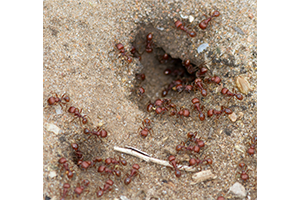Photo Credit: © Cullen Hanks, via iNaturalist.org. Creative Commons Attribution-NonCommercial 4.0 International (CC BY-NC 4.0) license, http://creativecommons.org/licenses/by-nc/4.0/.
Pogonomyrmex barbatus
Common Name: red harvester ant
Animal Guild: Insect
Class > Order > Family: Insecta > Hymenoptera > Formicidae
